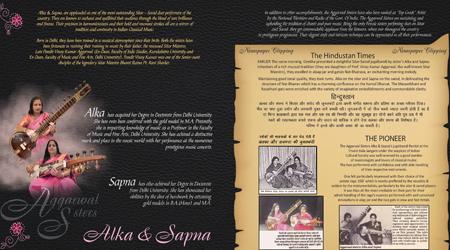New Launchs

The sitar & Sarod instrument used mainly in Indian Classical Music. The instrument descended from a similar but simpler Persian instrument called the Setar (meaning "three strings") and it's predecessor the Dutar (meaning "two strings"). It derives its distinctive timbre and resonance from design, a long hollow neck and a chamber. Sarod is too carry this features.
The Aggarwal Sisters are sustaining and upholding the tradition of chaste and pure music.In addition to other accomplishments, the Aggarwal Sisters have also been ranked as an "Top Grade" Artist by the National Television and Radio of the Govt. Of India. The Aggarwal Sisters are sustaining and upholding the tradition of chaste and pure music.In addition to other accomplishments, the Aggarwal Sisters is in first position, every performance.
The Aggarwal Sisters are sustaining and upholding the tradition of chaste and pure music.In addition to other accomplishments, the Aggarwal Sisters have also been ranked as an "Top Grade" Artist by the National Television and Radio of the Govt. Of India. The Aggarwal Sisters are sustaining and upholding the tradition of chaste and pure music.In addition to other accomplishments, the Aggarwal Sisters is in first position, every performance.

Indian classical music has seven basic notes with five interspersed half-notes, resulting in a 12-note scale. Unlike the 12-note scale in Western music, the base frequency of the scale is not fixed, and intertonal gaps temprament may also vary; however, with the gradual replacement of the Sarangi by the Harmoniyam an equal tempred scale is increasingly used. The performance is set to a melodic pattern called a raga characterised in part.
This is specific ascent and descent sequences, which may not be identical. Other characteristics include "king" and "queen" notes and characteristic phrases. In addition each raga has its natural register (ambit) and rules. Performances are usually marked by considerable improvisation within these norms. It is traditional for performers who have reached a distinguished level of achievement to be awarded titles of respect.
This is specific ascent and descent sequences, which may not be identical. Other characteristics include "king" and "queen" notes and characteristic phrases. In addition each raga has its natural register (ambit) and rules. Performances are usually marked by considerable improvisation within these norms. It is traditional for performers who have reached a distinguished level of achievement to be awarded titles of respect.
However, there are limits to how much what you see can override what you hear. That might happen for competition finals, where all performers are comparably excellent, but previous studies of the role of visual information in musical assessment have shown that trained musicians have no problem distinguishing between good and significantly poorer performances.Perhaps the key remaining question is whether the visual information is reliable helping us to pick out the most deserving winner, for instance or misleading, making us prefer performers who rely on visual flair rather than on musical depth.


